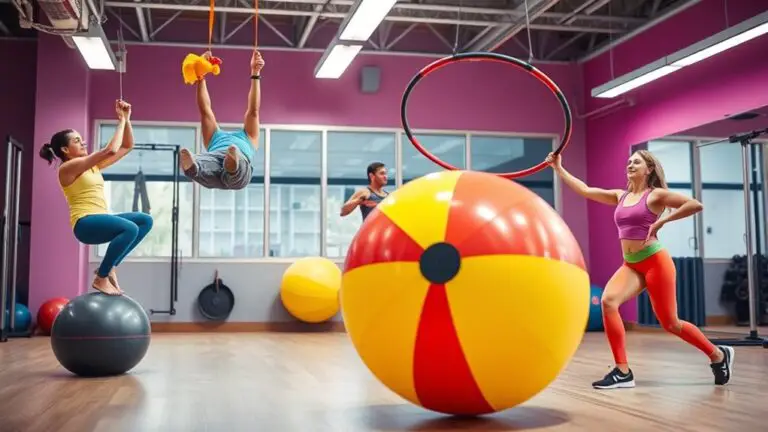Gym Workouts for Kids: How to Train Safely
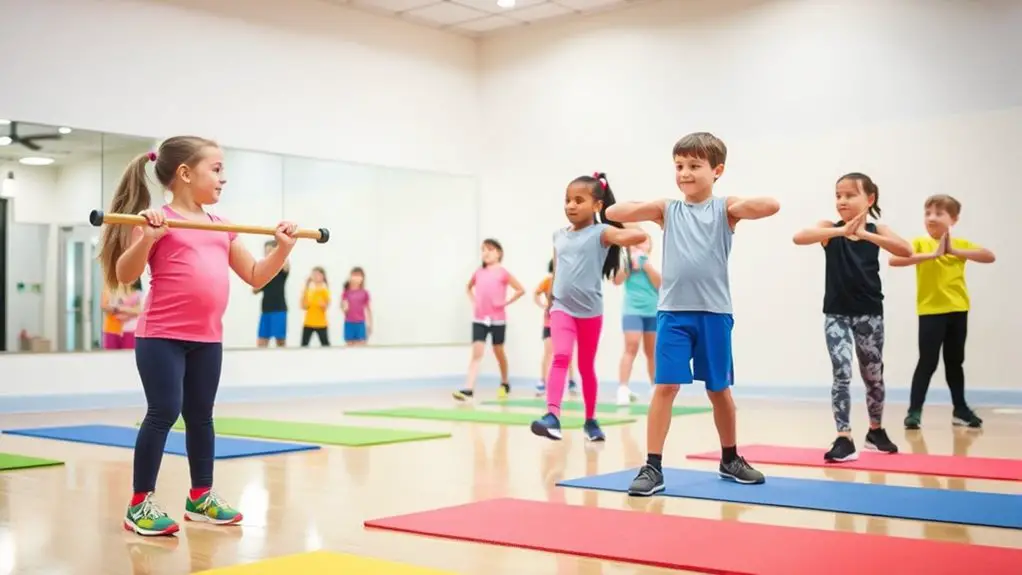
For safe gym workouts for kids, focus on age-appropriate activities that enhance fitness while ensuring fun. Kids aged 5 to 7 should engage in basic movements, while those 8 to 12 can start bodyweight exercises. Always supervise activities and prioritize warm-ups and cool-downs to prevent injuries. Encourage goal setting and celebrate achievements to boost motivation. When you prioritize safety and enjoyment, kids are more likely to develop a lifelong love for fitness. There’s still more to explore!
Understanding the Importance of Physical Activity for Kids
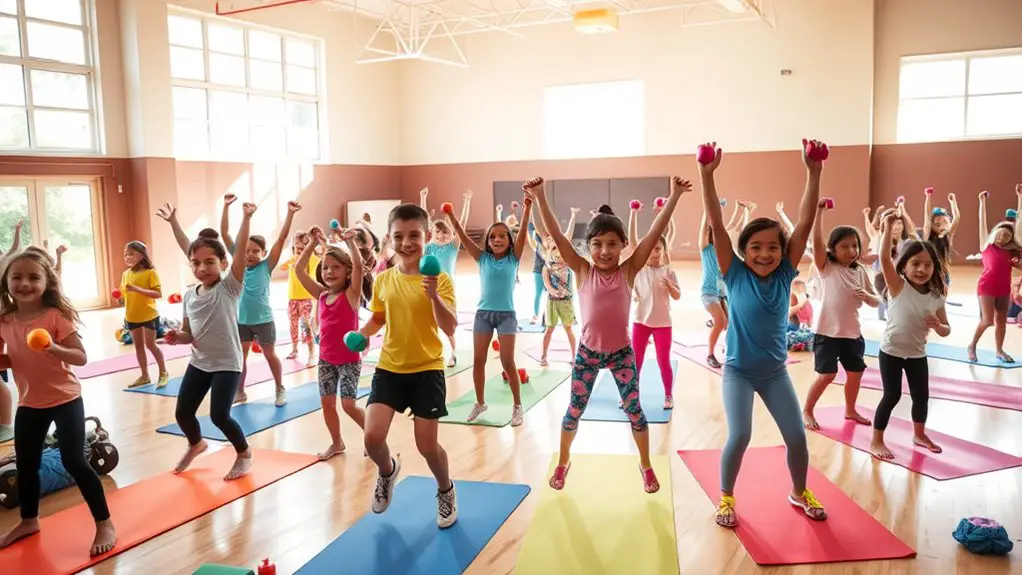
While many parents may prioritize academics and screen time, it’s fundamental to remember that physical activity is essential for kids’ overall health and development. Regular exercise supports child development by enhancing motor skills, coordination, and social interaction. It’s not just about fun; it’s about building fitness habits that can last a lifetime.
Engaging in physical activity helps kids maintain a healthy weight, boosts their mood, and improves concentration, which can positively impact their academic performance. Plus, it encourages teamwork and discipline, valuable skills they’ll need in life. Incorporating activities like skipping rope can provide effective cardio workouts that are not only fun but also beneficial for overall fitness.
To guarantee safety, it’s crucial to create an environment where kids can explore different activities and find what they enjoy. Supervision and age-appropriate guidance can help reduce the risk of injuries. By fostering a love for movement, you’re setting your child up for a healthier future, both physically and mentally.
Age-Appropriate Workouts: What to Consider
When planning workouts for kids, it’s important to take into account their age and developmental stage to guarantee safety and effectiveness. Age guidelines suggest that children aged 5 to 7 should focus on fun, basic movements like running and jumping, enhancing their coordination and motor skills. For kids aged 8 to 12, you can introduce simple strength exercises using body weight, emphasizing proper form over heavy weights.
As they reach their teenage years, around 13 and older, you can incorporate more structured workouts, including resistance training, provided they understand the importance of technique. Always consider their developmental milestones—each child grows at their own pace. Monitor their reactions and ascertain workouts align with their physical capabilities. Keeping it age-appropriate not only helps prevent injuries but also fosters a lifelong love for fitness. Remember, safety is key!
Fun and Engaging Gym Activities for Children
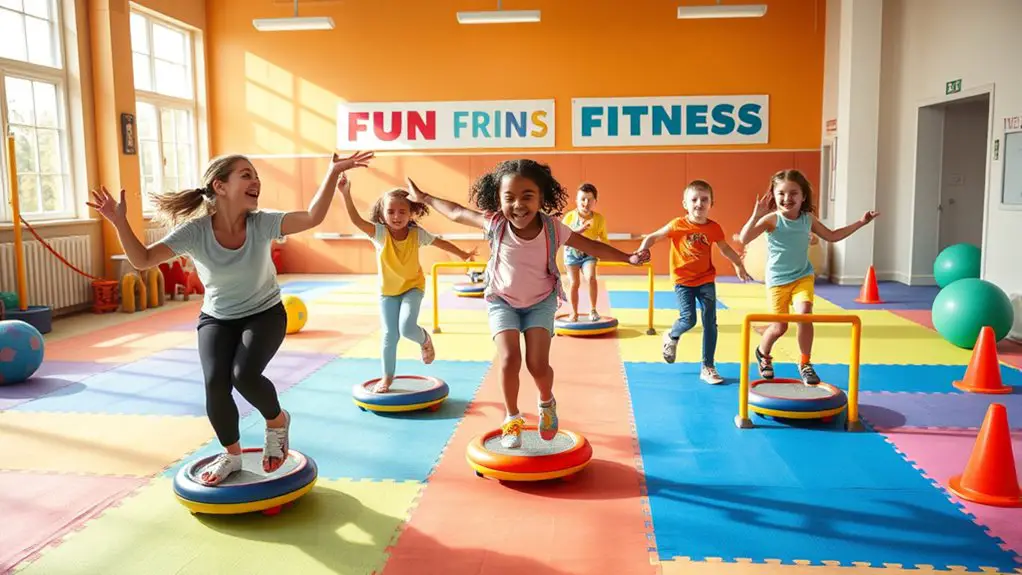
When it comes to keeping kids active, interactive games and challenges can make gym time a blast. You can encourage them to explore creative movements, turning exercise into an exciting adventure. Let’s look at some fun activities that will keep your little ones engaged and moving!
Interactive Games and Challenges
Kids love to move, and interactive games and challenges are a fantastic way to keep them engaged while they exercise. Incorporating team challenges into your gym routine fosters cooperation and makes workouts more enjoyable. You can set up interactive circuits that combine different activities, like relay races or obstacle courses, ensuring that kids not only have fun but also stay safe. Make sure the challenges are age-appropriate and provide clear instructions to prevent injuries. Encourage friendly competition and celebrate achievements, no matter how small. By allowing kids to participate in these exciting activities, you’re helping them develop a love for fitness while building teamwork skills. Remember, the goal is to promote fitness in a fun, safe environment!
Creative Movement Exploration
Exploring creative movement is a fantastic way for children to express themselves while getting active in the gym. By incorporating movement improvisation, kids can release their imagination, discovering new ways to move their bodies. You can set up safe, designated areas for playful exploration, where they can jump, crawl, and dance freely. Encourage them to mimic different animals or create their own movement sequences, fostering both creativity and physical skills. Always remind them to be aware of their surroundings to prevent injuries. Using props like scarves or balls can enhance the fun and keep them engaged. This approach not only builds physical strength but also boosts confidence and social skills as they share their unique movements with others.
Essential Safety Tips for Kids in the Gym
When kids hit the gym, safety should always come first. You need to make certain there’s proper supervision, choose age-appropriate exercises, and remember to include warm-ups and cool-downs. These steps can help create a safe and enjoyable workout environment for your child.
Proper Supervision Required
How can you guarantee your child’s safety while they’re having fun at the gym? Proper supervision is essential. Make sure a responsible adult is always present, whether it’s you or a trained staff member. Establish supervision strategies that include monitoring your child’s activities and encouraging them to ask for help if needed. Familiarize yourself with the gym’s safety protocols, like emergency procedures and equipment usage guidelines. It’s vital that your child understands the importance of following these rules. Encourage open communication about any concerns they have while working out. By prioritizing supervision and adhering to safety protocols, you can create a safe and enjoyable gym experience for your child, allowing them to focus on fitness and fun.
Age-Appropriate Exercises
Choosing age-appropriate exercises is essential for keeping kids safe and engaged at the gym. When selecting workouts, focus on activities that match their developmental stage. Here are three effective types of exercises:
- Bodyweight Exercises: Activities like push-ups, squats, and lunges help build strength without heavy equipment, making them safe for all ages.
- Flexibility Training: Incorporate stretching routines to enhance flexibility and prevent injuries. Encourage kids to practice basic stretches like toe touches and arm circles.
- Fun Movement: Include games and activities that promote physical activity, such as relay races or obstacle courses, to keep kids motivated and excited.
Warm-Up and Cool-Down
Incorporating a proper warm-up and cool-down into your gym routine is essential for keeping kids safe and injury-free. Start with dynamic stretches, like arm circles and leg swings, to get their muscles ready. This increases blood flow and reduces injury risk. After the workout, cool down with relaxation techniques such as deep breathing and gentle stretches. This helps their bodies recover and promotes flexibility.
| Warm-Up Activities | Cool-Down Activities |
|---|---|
| Arm Circles | Deep Breathing |
| Leg Swings | Gentle Stretches |
| High Knees | Child’s Pose |
The Role of Supervision in Kids’ Workouts
Supervision plays an essential role in guaranteeing kids’ workouts are safe and effective. When kids exercise, proper oversight can prevent injuries and promote healthy habits. Here are some key supervision techniques to contemplate:
- Set Clear Guidelines: Establish rules for exercises and guarantee kids understand them before starting.
- Monitor Progress: Regularly check on each child’s form and technique to make adjustments as needed.
- Encourage Communication: Create an environment where kids feel comfortable asking questions or expressing discomfort.
Building a Balanced Workout Routine
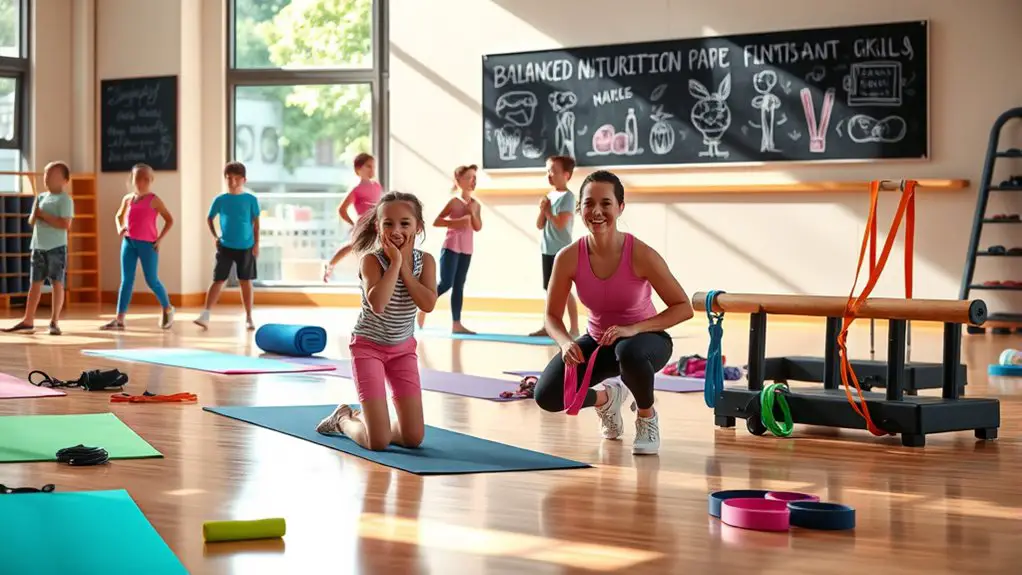
When creating a balanced workout routine for kids, it’s important to include a variety of exercises that target different muscle groups and promote overall fitness. Start with balanced strength training, focusing on bodyweight exercises like push-ups, squats, and lunges, which are safe and effective. Aim for two to three sessions a week, allowing rest days in between.
Next, integrate cardio activities to keep their heart healthy and improve endurance. Fun options like jumping rope, cycling, or playing tag can make cardio enjoyable. Ideally, kids should engage in at least 60 minutes of physical activity each day, combining both strength and cardio elements. Incorporating activities like jumping rope can not only enhance cardiovascular fitness but also contribute to a fun and effective workout experience.
Remember to incorporate flexibility exercises, like stretching, to prevent injuries and improve range of motion. By creating a routine that balances strength, cardio integration, and flexibility, you’ll help kids develop a love for fitness while ensuring they stay safe and healthy.
Encouraging Kids to Stay Motivated
To keep kids motivated in their fitness journey, it is essential to make activities enjoyable and engaging. Here are three effective strategies to help:
- Goal Setting: Encourage your kids to set achievable fitness goals. Whether it’s completing a certain number of push-ups or running a specific distance, having clear goals gives them something to aim for.
- Positive Reinforcement: Celebrate their achievements, no matter how small. Use praise or rewards to reinforce their efforts, which boosts their confidence and keeps them excited about training.
- Variety in Activities: Mix up workouts to avoid monotony. Incorporate fun games, challenges, or outdoor activities that keep them active and interested.
The Benefits of Team Sports and Group Activities
Participating in team sports and group activities not only enhances physical fitness but also fosters essential social skills in kids. Engaging in these activities helps your child understand team dynamics, promoting cooperation and respect among peers. Through friendly competition, they learn to handle wins and losses gracefully, which is vital for emotional growth.
Additionally, group settings provide valuable leadership opportunities, allowing kids to step up and guide others while building their confidence. Enhanced communication skills develop naturally as they interact with teammates, which can benefit them in various aspects of life.
Moreover, team sports can cultivate a sense of belonging, helping your child forge lasting friendships. As they work together towards common goals, they’ll not only stay active but also grow socially and emotionally. Encouraging your child to participate in these activities can set a solid foundation for a healthy, well-rounded life.
Frequently Asked Questions
What Types of Equipment Are Safe for Kids to Use in the Gym?
When it comes to gym equipment for kids, it’s not like you’re handing them a rocket launcher! Instead, think about safe options like resistance bands and stability balls. Resistance bands are fantastic for building strength without heavy weights, while stability balls help improve balance and core strength. Always supervise their workouts to guarantee they’re using the equipment correctly and safely. Keeping it fun and safe makes all the difference in their fitness journey!
How Can Parents Support Their Kids’ Fitness Goals at Home?
To support your kids’ fitness goals at home, you can encourage them to establish safe fitness routines tailored to their interests. Join in on the fun—your parental involvement can motivate them and create a positive atmosphere. Set achievable goals together, and celebrate their progress. Make sure to prioritize safety by supervising their activities and ensuring they use appropriate equipment. Remember, it’s all about fostering a healthy lifestyle while keeping it enjoyable!
Are There Any Specific Nutrition Tips for Active Children?
Did you know that only 1 in 5 kids meets their daily nutritional needs? To help your active child thrive, focus on nutritional balance by including fruits, vegetables, lean proteins, and whole grains in their meals. It’s also essential to pay attention to their hydration needs; encourage them to drink water before, during, and after physical activities. Supporting their health with these tips can guarantee they stay energetic and safe while being active!
How Can Children Prevent Gym-Related Injuries?
To prevent gym-related injuries, it’s essential to focus on injury prevention. Always start with safe stretching to warm up your muscles and improve flexibility. Encourage your child to listen to their body and avoid pushing through pain. Verify they use proper techniques and equipment suited for their age and ability. Supervision is important, too; having a knowledgeable adult around can help guarantee safety during workouts. Prioritizing these practices will keep them active and injury-free!
What Are Signs That a Child Is Overexerting Themselves During Workouts?
When you’re watching a child during workouts, it’s essential to look for fatigue indicators and stress signs. If they’re complaining of excessive tiredness, struggling to keep up, or showing signs of irritability, it might mean they’re overexerting themselves. Sweating excessively or having difficulty catching their breath are also red flags. Encouraging breaks and monitoring their energy levels can help guarantee they stay safe and enjoy their activity without pushing too hard.

